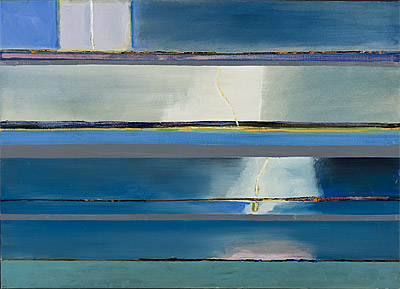
By Rama Gaind
Visiting the National Gallery of Australia, in Canberra, was an enlightening experience.
It houses, until November 6, 2011, an exhibition of works that showcases the works of one of Australia’s greatest artists – Fred Williams.
Aptly titled Fred Williams: Infinite horizons, this display evokes a sense of wonder and unbridled respect for his artistic capability and creativity.
This is the first major retrospective of Fred Williams’ work in more than two decades.
The unique Australian landscape inspired one of Australia’s greatest painters to create some magical works of art.
He created a highly original and distinctive way of seeing the Australian landscape and was passionate about the painting process itself.
One of Australia’s most influential and much-loved artists, this display highlights his strength as a landscape artist and includes important oil paintings and luminous gouaches that reveal his distinctive approach.
Fred Williams (1927-1982) created a highly original way of seeing the Australian landscape, often combining a feeling for place with an emphasis on the abstract. Although best known as a painter of the dry landscape, this retrospective reveals that he was also a remarkable painter of water: seascapes, ponds, creeks, billabongs and waterfalls.
Providing valuable insight, exhibition curator Dr Deborah Hart said Fred Williams connected with the landscape.
“He loved the variety of the landscape and painted it with great balance and interest in structure, reinventing where horizons take on a different perspective,” Dr Hart said.
“Gouache and watercolour were his preference.”
“He used red and orange to evoke the feeling of the Australian bush,” she said. “He said, ‘I’ve got this fierce desire to paint colour’ … Landscape with Water Ponds was done in rich colour, and he gave multiple viewpoints in a strip.”
“He was always challenging himself. Fred regarded Forest of Gum Trees III, an oil on canvas, as “one of my best paintings’.”
For Fred Williams, the painting process was a stealthy one. As Dr Hart revealed, “Fred Williams used to say, ‘I wasn’t in a hurry then and I’m still not now’.”
‘Minimal approach’
Walking through, looking at the hung paintings, listening to the commentary and viewing the variety of work, you note that each of the display rooms had different moods. “Minimal approach is used to give a feeling of space … it’s all about the power of placements”.
Fred Williams was the first Australian painter to have an exhibition in New York in 1977.
This retrospective of Williams’ work in more than 25 years highlights his strength as a painter including important large oil paintings and luminous gouaches to reveal his distinctive approach, often combining a feeling for place with a strong abstract emphasis.
There’s an astonishing range of iconic paintings inspired by the distinctive Australian landscape from Upwey in Victoria to the Pilbara in Western Australia and Weipa in North Queensland, together with some portraits of family and friends.
Another exhibition at the NGA
The Aboriginal and Torres Strait Islander art collection at the National Gallery of Australia comprises over 7500 works and is the largest in the world.
These new gallery spaces allow much more of the collection to be seen with each one specifically designed for a different geographic region or aspect of Indigenous art and, where possible, paintings and sculptures are illuminated overhead by natural daylight, akin to the light in which the works were created.
Curator of Aboriginal and Torres Strait Islander Art at the gallery Tina Baum elaborated on the art of contemporary Indigenous Australians taking many forms.
She said the works of art were a testament to the rich cultural knowledge, expertise and ingenuity of their creators.
A particular mention has to be made of The Aboriginal Memorial that consists of 200 hollow log coffins from central Arnhem Land in the Northern Territory and is one of the most significant Indigenous works of art in the gallery’s history. It was created in 1987-88 by about 43 Aboriginal artists from Ramingining and the surrounding area.
Each pole represents a year of European occupation and together they stand as a memorial to all the Aboriginal and Torres Strait Islander people who lost their lives during the colonial occupation in Australia from 1788 to 1988.
The path through the installation represents the Glyde River in central Arnhem Land. Ms Baum said the poles were located along the river according to their specific homeland. “It is referred to as the ‘Forest of Souls’.”
Despite significant change and diversity, the art retains an underlying unity of inspiration—the land and the peoples’ relationships with it. It is simultaneously connected to the past and engaged with the present, engaging with the world through actions that are lively, positive, political, social and creative.
Among the 19th-century objects in Gallery 2 are delicate baskets made in the 1800s. They are works of art that are a testament to the skill, wealth of cultural information and resourcefulness of their creators.
This dedicated display highlights the diversity, richness and excellence of the collection.
Check out the New Aboriginal & Torres Strait Islander art galleries, in person at the NGA, or visit http://nga.gov.au/atsiart/
What you need to know
National Gallery of Australia, Canberra
Fred Williams: Infinite horizons
Exhibition ends November 6, 2011
10am-5pm daily
Entry is $15 adults, $10 members/concession. Children under 16 free.
http://www.nga.gov.au/williams








